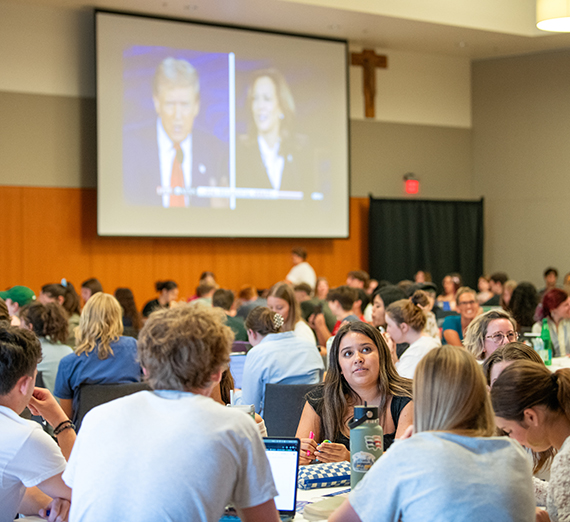Debate Watch, Ignatian Style

As presidential candidates Kamala Harris and Donald Trump embarked on their first debate on Sept. 10, Gonzaga faculty members and students packed the Hemmingson Ballroom to listen and learn together.
Sarah James from political science, and Rebecca Donaway and Glen Frappier from communication studies, set the stage for the event.
“A debate is an opportunity for the candidates to present their views so viewers can make informed decisions,” James said. “It’s less about content and more about building affiliation and rapport, and showing their persona – their vibe.”
Frappier recalled the first presidential debate he hosted: Bush/Gore in 2000. Over 24 years of such events, Frappier said, “This is the craziest political summer we’ve ever had,” citing the attempted assassination of Trump, a poor debate performance by President Joe Biden (“the worst debate performance by a sitting president”) and his turning over the candidacy to a vice president.
“Focus on the argument and the reason to support it,” Frappier said. “If you are an undecided voter, please know that your vote is one of the most powerful things you have.”
Final advice for students came from Donaway as she drew attention to Gonzaga’s Jesuit heritage and pointed to fliers on each table with advice based on what St. Ignatius gave the Jesuits attending the Council of Trent in the mid-1500s:
-
Learn the surpassing worth of conversation
-
Pay attention to the whole person
-
Understand the meaning, learnings and wishes of those who speak
-
Be free of prejudice
-
Argue from authority cautiously
-
Quote important persons only if arranged beforehand
-
Consider the reasons on both sides without showing attachment to your own opinion
-
Be modest when you are certain
-
Choose to speak at the other's convenience even when certain
-
Give conversation the time that it needs
At the first commercial break, debate team members answered questions that the audience submitted on topics the candidates mentioned, including: inflation, unemployment, economy, immigration, taxes, abortion, fentanyl, rally sizes, presidential popular votes, health insurance and Afghanistan.
After the debate conclusion, the hosting professors shared some of the aspects they noted from their respective disciplines: How some of the candidates’ answers were specifically directed to swing states, clips of the debate they believe the media will use most, the training debaters may have had around facial expressions and speaking to the TV audience, as well as the significance of Harris choosing which side of the stage to be on (the right side, for reasons of visual tracking among TV viewers).
Among the more than 250 attendees, only 15% indicated in their registration as coming to fulfill a course requirement. It was clear from discussion at tables that the majority of students were there out of personal interest.
The event concluded with a reminder of the Sept. 17 voter registration event on campus.


